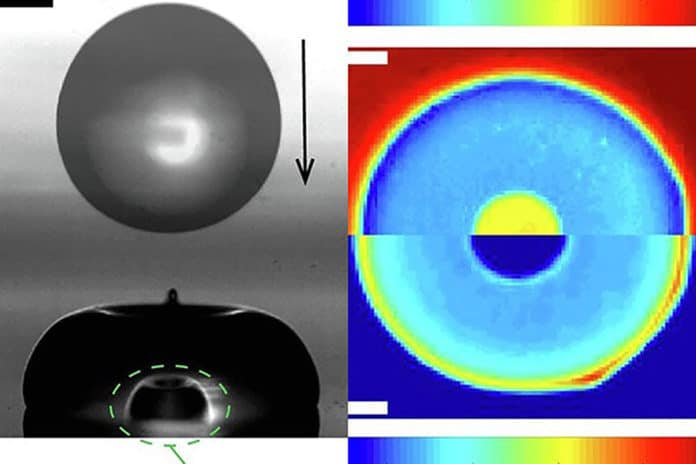Using high-speed imaging methods, scientists at the McKelvey School of Engineering at Washington University in St. Louis have studied a microscopic entrapped bubble that forms when water droplets hit a heated, smooth, water-repellent surface. They found that heat’s conduction plays a bigger role than previously thought in the dynamics of droplets on soft surfaces that repel water.
The bubble that scientists studied was only a few hundred microns in size. It forms inside a water droplet by absorbing the air underneath it to lift off from the surface.
Patricia Weisensee, assistant professor of mechanical engineering & materials science, said, “We’re creating capillary waves on the droplet because as the droplet impacts, it compresses, and that sends a shockwave through the droplet and creates a doughnut-shaped droplet with the air bubble entrapped in the middle.”
Scientists tested the water droplets on three heated surfaces: Teflon and two materials with similar surface chemistry: PDMS, a biocompatible material, and HTMS, a hydrophobic silane-based monolayer coating. Later, they used synchronized high-speed optical and high-speed infrared imaging to determine the heat transfer from the smooth surface to the water droplet.
They found that the amount of heat transferred from the smooth surface to the water droplet increases with increased spreading velocity. They also found that the increase in surface temperature changes the size and shape of the bubble.
Interestingly, during the retraction of the droplet, the total heat transfer was reduced by 5.6% and 7.1% at surface temperatures of 50C and 65C, respectively, as the bubble reduced the total liquid-solid interface area. Despite the process lasting for a few seconds, it profoundly influences the cooling efficiency and droplet dynamics of these systems.
Weisensee said, “We found that thermal conduction was the most prominent form of heat transfer during droplet impact over convection or evaporation.”
Scientists also tested the droplets on a rough surface. Due to enhanced friction, the droplets showed a smaller spreading area, smaller heat transfer area, and, consequently, a lower heat transfer rate. This lowers the efficiency of, for example, spray cooling processes.
Weisensee said, “Though we used heated surfaces for this particular study, our findings also have implications for other systems where you have droplets impacting a surface, such as a windshield, an airplane wing, or a wind turbine blade. For example, in cold conditions, you don’t want the droplets to stay there and freeze. Lifting off is important to don’t flood a surface or accumulate a lot of liquid on the surface. So you need to know the interplay of droplet dynamics and heat transfer.”
Journal Reference:
- Li J, Weisensee P. Low Weber number droplet impact on heated hydrophobic surfaces. Experimental Thermal and Fluid Science, Issue 130, Jan. 1, 2022 print issue. DOI: 10.1016/j.expthermflusci.2021.110503
